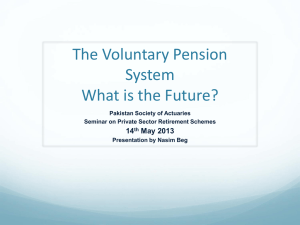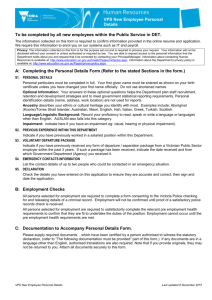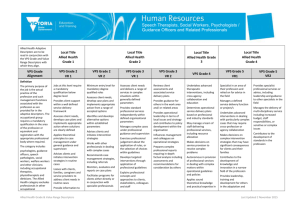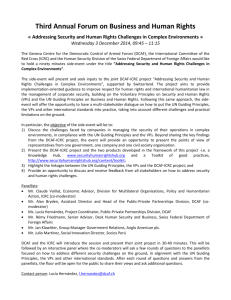Voluntary Pension System (VPS)
advertisement
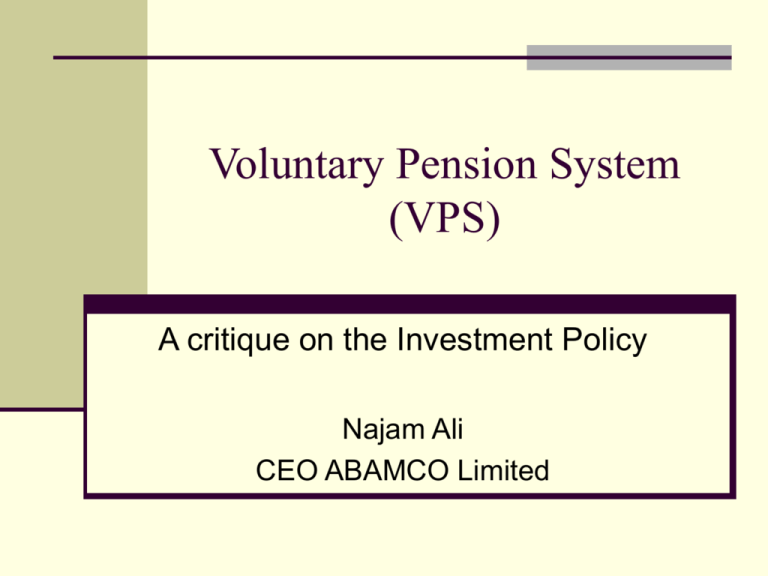
Voluntary Pension System (VPS) A critique on the Investment Policy Najam Ali CEO ABAMCO Limited Presentation Overview VPS Structure Sub-Funds VPS Asset Allocation Investment Process Critique on Asset Allocation Requirements Investor Goals and Constraints International Comparison Prudent Person Rule versus New Prudent Investor Rule Qualitative versus Quantitative Diversification VPS Investment Limits Critique on regulations VPS – A long way to go VPS – The Structure The Voluntary Pension System – a self-contributory pensions savings scheme No restriction on the employer to join in and contribute to its employees pension Max contribution limit of PkR 500,000 p.a. by any individual Relaxation for participants joining the pension plan after the age of 41 Allowed an additional contribution of 2% p.a. Total contribution must not exceed 50% of the individual’s total taxable income VPS – Sub-Funds VPS – a scheme with three sub-funds: Equity Sub-Fund Debt Sub-Fund Money-market Sub-Fund Additional classes such as real estate and international investments may be added later Asset allocation as per participant’s return objectives and levels of risk aversion VPS – The Pooled Fund Equity Sub-Fund Debt Sub-Fund Money-Market Sub-Fund VPS – Asset Allocation Pension fund managers (PFMs) to invest with: Transparency Efficacy Prudence Soundness PFMs to offer at least 4 pre-set asset allocation schemes: Allocation Scheme Debt Sub-Fund Equity Sub-Fund Money Market Sub-Fund Aggressive 20%-35% 65%-80% Nil Balanced 40%-55% 35%-50% 10%-25% Conservative 60%-75% 10%-25% 15%-30% Very Conservative 40%-60% Nil 40%-60% VPS – Investment Process of an IPA Part 1: Formation of an Investment Policy Participant chooses asset allocation scheme, e.g. Aggressive Yes PFM chooses percentage of contributions to go in each sub-fund, e.g. Equity: 80%, Debt: 20%, MM: 0% REGULATION: Percentages not to change more than once in a given calendar year No PFM assigns investor to Conservative or Very Conservative scheme VPS – Investment Process of an IPA Part 2: Monthly Fund Flow PkR 8,000 Equity PkR 10,000 Investor PkR 2,000 PMF Trustee Debt PkR 0 MM VPS – Critique on Asset Allocation Potential inefficiencies due to overly structured asset allocation: Structured asset allocation schemes may not be applicable to all investors An individual’s position in a defined asset allocation scheme may hamper his/her investments from growing at competitive and efficient rates Limitation of only one change per year in the percentage of contribution to each sub-fund is too restrictive as investor preferences, abilities and characteristics are dynamic – so should the asset allocation Recommendations: The limit on rebalancing and switching between investment classes should be increased to twice a year Rather than defined allocation schemes, each IPA’s investment policy should be in accordance with the participant’s characteristics Investors should have the flexibility to invest any fraction in a particular class for example 100% in equities VPS – Critique on Asset Allocation Recommendations (cont.): Investments should be made on principles of diversification, maximizing returns to participants and limiting risk Investor’s objectives and constraints should be evaluated before formulating the investment policy (unlike predetermined allocation) Product differentiation should be encouraged; else All PFMs follow similar investment objectives Higher marketing and administrative costs Investment managers should be given more autonomy and flexibility to evaluate an investor’s risk level and use their prudent judgment in devising the optimal investment policy VPS – Investor Goals & Constraints A common global practice: To evaluate investor goals and constraints before formulating an investment policy – a law in UK Appraisal forms to judge the willingness and ability of the investor to take risk Rule of thumb: Go by the willingness to take risk, unless the ability is less than the willingness Asset Managers (are sometimes required by law) to only offer those investment opportunities to the investor, which are in line with their risk aversion level Fallbacks in the VPS Rules: No requirement to evaluate investor objectives Allows investors to make decision and choose scheme Or if no decision by investor – assign to Conservative or Very Conservative scheme – possibly inefficient May not maximize investor’s utility VPS – Investor Goals & Constraints Recommendations: The investment policy (IP) should not be pre-formulated Choosing a scheme on an ad-hoc basis should not be completely in hands of the investor In line with international standards, the IP should be determined after thorough analysis of the investor’s attributes Level of risk aversion must be determined by asset manager before offering an allocation style An institutionalized criteria of assessing investors’ level of risk aversion, such as that in Canada, should be introduced PFMs should require investor’s to fill and sign risk assessment forms in order to determine the level of risk Specialized software may be used for this purpose PFM must clearly explain the risk/return characteristics of a plan to the investor VPS – International Comparison The Prudent Person Rule Governs the actions of the asset managers in developed nations such as US, EU, Canada, Finland and Japan, along with many developing countries Charges fiduciaries with conducting themselves with the same degree of judgment, reasonableness and prudence in administering the affairs of their clients, as they would in their own personal affairs The New Prudent Investor Rule Replacing the old rule due to certain unnecessary limitations When dealing in their clients’ affairs, the new rule calls on asset managers to “observe how men of prudence, discretion and intelligence manage their own affairs, not in regard to speculation, but in regard to the permanent disposition of their funds, considering the probable income, as well as the probable safety of the capital to be invested" Calls for diversification, capital growth and safety, and implementation of investment decisions in the context of the whole portfolio Such rules should also govern the actions of investment managers in Pakistan in order to gear the investment process to the benefit of the participants VPS – International Comparison Two investment regulation approaches Qualitative Quantitative Qualitative A prudent approach urging diversification No defined investment limits Followed in US, UK, Netherlands and Australia Quantitative Another prudent approach geared toward diversification Provides clear cut limits on asset allocation and investment avenues Followed in EU, Canada, India, Philippines and now in Pakistan VPS – Qualitative Approach Features: Diversification requirement is stated as general principle UK explicitly requires fiduciaries to develop a statement of investment policy to guide decisions US requires no explicit point in this rule Perspective in Pakistan Market too regulated to have qualitative approach Qualitative approach suits free markets Too many groups in small market constraints the ideal free market In essence, Qualitative approach is not appropriate for Pakistan VPS – Quantitative Approach Main Feature: Imposes quantitative limits related to diversification Examples Canada 5% in Real Estate Investment of funds portfolio 30% in foreign investment of funds portfolio Italy 15% in single investment of funds portfolio EU 30% cap on investments in unregulated markets 5% cap on investment in a particular scrip 10% cap on investment in scrips issued by a particular group Philippines 25% cap on investments in equities 25% cap on investments in real estate 10% of maximum allowable investment in a single asset VPS – Investment Limits Equity Sub-Fund 5% cap on investment in shares of a company, 20% in a sector 1% cap on investment in any one green field company Total investment in green fields not more than 5% of NAV Investment in shares of only those listed companies that have an operational history of 5 years Proposed amendments: Green field projects must be clearly defined. Is a green field An IPO, or A newly established venture? Restriction of investment in issues of companies with less than 5 years of operational history hampers prospects to reap gains from certain excellent growth opportunities Some restrictions should be imposed to ensure liquidity of funds e.g. India’s proposal of PFs only investing in index shares VPS – Investment Limits Debt Sub Fund Debt sub fund consist of tradable securities with weighted average duration of less than 10 years At least 50% of the assets will be invested in federal government securities Proposed amendments to overly restrictive regulations Duration term should not be restricted as investors with long term investment horizon (purpose of pension investment) will not be able to gain from high yield long term investments Minimum 50% investment in government securities would mean high credit quality but low returns Such restrictions carry no international significance especially in Pakistan’s emerging corporate bond market VPS – Investment Limits Money Market Sub Fund Weighted average duration of the fund should not exceed one year No restriction on investment in government securities All other securities capped at 20% Close to retirement a participant would be most heavily invested in the money market considering its safe and short term nature VPS – A long way to go The VPS is yet in its infancy. Nevertheless, it is a much needed product and is the call of the time As individuals become more and more independent and living standards increase, saving up for retired life is the rational way to go The success of the system will be dependent on its adaptability to the joint-family system and demographics of the Pakistani society Awareness and education about the benefits of pension plans will be necessary for the VPS to gain widespread acceptance Following the examples of developed and other developing nations the VPS can be implemented in Pakistan. The product will be a success as long as it offers flexibility and ease to the investors to save up for their retired life Thank You!
